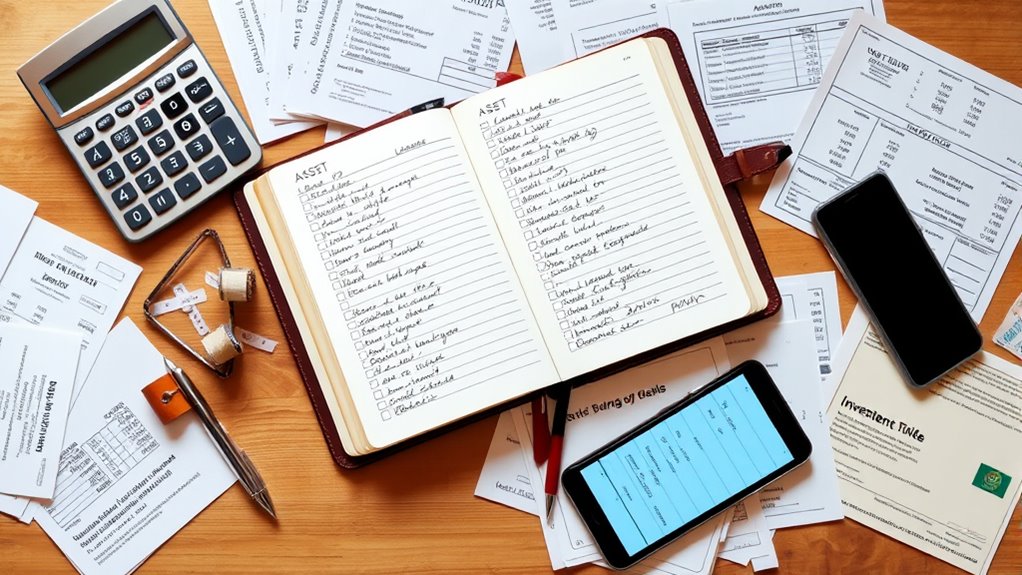To calculate your net worth, list all your assets like savings, investments, property, and valuable possessions. Then, add up all your liabilities such as loans, credit card debt, and unpaid taxes. Subtract your total liabilities from your total assets to find your net worth. Make sure your figures are up-to-date and accurate. Using tools or apps can help simplify this process, and exploring more details can further refine your overall financial picture.
Key Takeaways
- List all your assets, including cash, investments, property, and valuable possessions.
- Record all liabilities such as mortgages, loans, credit card debt, and unpaid taxes.
- Sum total assets and total liabilities separately for an accurate overview.
- Subtract total liabilities from total assets to determine your net worth.
- Regularly update and verify your figures to track financial progress and ensure accuracy.
Understanding What Net Worth Signifies

Understanding what net worth signifies is essential for evaluating your overall financial health. Your net worth is the difference between what you own—your assets—and what you owe—your liabilities. It provides a clear snapshot of your financial position at any moment. This figure includes both financial assets, like savings and investments, and non-financial assets, such as property or vehicles. It’s a crucial metric because it reflects your ability to manage debt and build wealth over time. Unlike income, which shows how much money you make, net worth indicates your saving and spending habits. A positive net worth means you own more than you owe, signaling financial stability, while a negative net worth suggests you might be facing financial challenges. Tracking this number helps you understand your progress toward long-term financial goals. Additionally, understanding the role of Retirement Planning strategies can help you enhance your net worth over time. Developing effective investment strategies can further improve your financial standing and secure your future.
Gathering Your Asset Information

To accurately calculate your net worth, start by gathering detailed information about your assets. Begin with cash and liquid assets like funds in checking, savings, and money market accounts. Next, include your retirement accounts such as 401(k), IRA, or pension funds. List your investments, including stocks, bonds, mutual funds, and cryptocurrencies. Don’t forget real estate—both your primary residence and any rental or investment properties—by noting their current market value. If you own a business or partnership, determine its worth. Additionally, consider major assets like vehicles, artwork, jewelry, and high-value personal property. For assets like intellectual property, royalties, or specialized equipment, estimate their value. Recognizing patterns in angel numbers can also provide insight into your financial and emotional readiness, helping you better understand your overall wealth. Exploring wealth-building strategies can offer valuable approaches to increasing your net worth over time. Incorporating personal development techniques such as visualization and goal setting can enhance your financial clarity. Understanding the significance of asset valuation ensures you are accurately assessing the worth of your possessions. Collecting this extensive information ensures an accurate picture of your total assets before moving on to liabilities.
Listing Your Liabilities Accurately

Have you listed all your liabilities accurately? To do this, include all relevant categories such as mortgage loans, vehicle loans, student loans, credit card debt, and personal loans. Don’t forget accounts payable, unpaid taxes, home equity loans, medical bills, and legal obligations like alimony or child support. Use the most recent balances for each liability, and consider interest rates and payment deadlines to guarantee accuracy. Record the principal amounts and any additional fees or penalties. Organize your liabilities using spreadsheets, budgeting apps, or ledgers for clarity. Regularly review and update your liability information with current account statements. If you have multiple high-interest debts, consider consolidation or professional advice to manage them effectively. Understanding liability management techniques can help you reduce debt burdens more efficiently. Conducting a thorough review can also reveal hidden liabilities that might otherwise be overlooked. Accurate liability listing is essential for a true picture of your net worth.
Valuing Your Assets Correctly

Accurately valuing your assets is key to calculating your net worth, but it requires more than just listing what you own. You need to understand different valuation methods, like the cost, market, and income approaches. For example, creating a cozy farmhouse bedroom can involve assessing the value of vintage decor or custom furniture, which may require specific valuation techniques. Using tools like professional appraisals, market data, and financial statements helps you determine precise values. Remember, applying the right method for each asset guarantees your net worth calculation is accurate and reflective of current market conditions. Additionally, understanding the potential pitfalls in adopting new payment technologies can help you evaluate the security and reliability of financial assets or systems associated with your holdings. Being aware of vetted sources for financial information ensures your valuations are based on trustworthy and current data.
Calculating Total Assets and Liabilities

Understanding how to calculate your total assets and liabilities is vital for determining your net worth. To find your total assets, add up your current assets—cash, accounts receivable, inventory, prepaid expenses, and short-term investments—and noncurrent assets like property, equipment, intangible assets, long-term investments, goodwill, and deferred charges. These are listed on your balance sheet.
To calculate liabilities, sum your current liabilities, such as accounts payable and accrued expenses, with noncurrent liabilities like mortgages and bonds. Confirm both methods agree: total assets should equal the sum of liabilities and equity.
Accurately identifying and totaling these figures provides a clear picture of your financial position. This step is essential before moving on to subtract liabilities from assets to determine your net worth.
Subtracting Liabilities From Assets

To determine your net worth accurately, you need to subtract your total liabilities from your total assets. This calculation gives you a clear picture of your financial health. Being aware of your financial security is essential for planning future goals. First, verify you’ve listed all your assets, like savings, property, and investments, and assigned accurate values. Then, account for all liabilities, including mortgages, credit card debt, car loans, and unpaid bills. Once you have these totals, subtract your liabilities from your assets. The result is your net worth, which reflects your overall financial position. A positive net worth indicates you own more than you owe, while a negative one shows liabilities outweigh your assets. Regularly performing this subtraction helps you track progress toward your financial goals and identify areas for financial improvement. Additionally, understanding your asset valuation ensures your calculations are precise and meaningful, and staying informed about industry trends can help you make better financial decisions.
Verifying Your Financial Data

Have you ever wondered if the financial data you rely on is correct? Verifying your financial data is essential to ensure an accurate net worth calculation.
Ensuring your financial data is accurate is vital for reliable net worth calculations and financial clarity.
Start with data type checks to confirm all figures are numeric and correctly formatted. Validate codes like bank account numbers against trusted lists to prevent errors.
Compare data from different sources to spot inconsistencies, and regularly review records to maintain accuracy.
Use automated validation tools and continuous monitoring systems to catch discrepancies early. Verify financial documents match your records, ensuring completeness and consistency across all reports.
Maintain audit trails of changes for transparency. By consistently verifying your financial data, you reduce errors and gain a clear, trustworthy picture of your net worth.
Utilizing Tools to Simplify the Process
Using financial tools can considerably simplify the process of calculating and tracking your net worth. Platforms like NerdWallet’s calculator automatically subtract liabilities from assets, providing quick results. Payment security features in these tools help ensure your sensitive financial data remains protected during the process. Schwab’s MoneyWise estimates net worth and projects changes over ten years, while Merrill Edge offers an all-encompassing financial overview. Empower (formerly Personal Capital) links your accounts for real-time updates and investment analysis, ensuring accurate tracking. These tools automate data input, reducing manual effort and minimizing errors. They also help visualize your financial progress through dashboards and graphs, motivating you to stay on course. Many tools integrate budgeting features, manage subscriptions, and allow manual account entries for assets without online access. Additionally, understanding supermarket hours can help you plan your shopping trips more efficiently, ensuring you access your essentials when stores are open. Incorporating dream journaling techniques can improve your awareness of financial habits that influence your net worth, leading to better decision-making. A clear understanding of toilet flushing mechanisms can also contribute to better resource management at home, indirectly supporting your financial goals. To enhance your financial understanding, familiarizing yourself with narcissistic behaviors can be helpful if you’re managing complex relationships that impact your financial situation.
Tracking and Updating Your Net Worth Regularly

Regularly tracking and updating your net worth is essential for maintaining an accurate picture of your financial health. It helps you see how your assets compare to liabilities, giving you a clear overview of your financial situation. Monitoring your net worth also allows you to measure progress toward goals like retirement savings and helps keep you motivated by showing improvements or setbacks. Consistent updates enable proactive planning and better decision-making, ensuring your calculations stay accurate and relevant over time. Including diverse assets such as investments, real estate, and cash can provide a more comprehensive view of your net worth. Include all assets—cash, investments, real estate—and liabilities like loans and credit card debt. Choose an update frequency that fits your situation, whether monthly, quarterly, or annually, especially around major financial milestones. Regular tracking empowers you to adjust your strategies, manage risks, and stay focused on your financial goals.
Frequently Asked Questions
How Often Should I Update My Net Worth Calculation?
You’re wondering how often to update your net worth calculation. It depends on your financial goals and how closely you want to monitor your progress.
If you’re saving for a big goal or tracking investments, updating monthly or quarterly works best.
For general awareness and less stress, annual or semi-annual updates are sufficient.
Balance frequency with avoiding obsession, and choose tools that suit your lifestyle for consistent tracking.
What’S the Best Way to Value Unique Assets Like Jewelry?
Valuing unique assets like jewelry is like finding a rare gem—you need the right tools. You should compare your item to similar pieces recently sold, consult a professional appraiser, or use specialized indices for collectibles.
Keep detailed records of your jewelry’s purchase and appraisal history. This approach guarantees you get an accurate value, especially since subjective factors like sentiment or market fluctuations can influence worth.
How Do I Handle Debts With Fluctuating Interest Rates?
When handling debts with fluctuating interest rates, you should consider strategies like refinancing to fixed rates, which stabilize payments.
Keep an eye on market trends and central bank decisions to anticipate rate changes.
Use hedging tools like interest rate caps or swaps to limit risks.
Prioritize paying down high-interest debts first and maintain a strong cash flow to stay prepared for rate increases.
Regularly review your debt structure for ideal management.
Can I Include Future Income or Inheritances in My Net Worth?
Imagine your financial future as a garden waiting to bloom—don’t let it be overshadowed by today’s uncertainties. You can’t include future income or inheritances in your current net worth because it’s a snapshot of your present financial health.
While these future gains influence your planning, they aren’t part of your current assets and liabilities. Focus on what you have now to build a strong foundation for your financial growth.
What Should I Do if My Assets Outweigh My Liabilities?
If your assets outweigh your liabilities, you’re in a strong financial position. You should focus on maintaining and growing this positive net worth by diversifying your investments, paying down any remaining high-interest debt, and building an emergency fund.
Regularly review your asset performance and consider reinvesting profits to maximize growth. Keep setting financial goals, stay disciplined, and consult with a financial advisor to guarantee your wealth continues to increase.
Conclusion
Now that you know how to calculate your net worth, think of it as your financial GPS, guiding your money journey. Regularly updating this figure keeps you on course and aware of your progress. Remember, just like a garden needs tending, your finances thrive with consistent attention. Keep tracking, stay informed, and watch your financial landscape flourish as you steer toward your goals with confidence.










